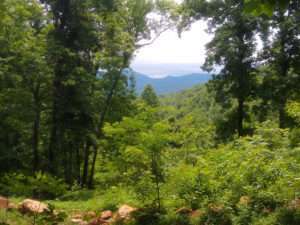A Visit to Little Bluestem by Eric Olson-Getty, Director of Programs

Our day started with a pinch of dried tobacco sprinkled gently on the forest floor. I had never done anything like this before – such offerings are not a part of the faith tradition that formed me – but it was an invitation to slow down, to breathe for a few moments, introduce myself, offer my good intentions and gratitude to this place I was about to disrupt. Hopefully the disruption would bring healing. As if on cue, I took a deep breath, opened my eyes, stood up, and there in front of me was a piece of cheap plastic lawn furniture, held out to me in the fingers of the brush, as if to say, “please get this thing out of here!”
Over the years I have spent many days in the forest and the mountains, running and hiking, seeking out solitude and traversing the contours and vistas of the landscape and, to some extent, fleetingly watching the creatures who inhabit it if they reveal themselves to me along the way. Today I had already arrived several hours early to run and hike the unmarked trails and old logging roads snaking up the flanks of the mountains. But the tobacco ritual shifted the way I moved through, perceived, and interacted with the space. It invited me into a relationship of care and mutuality with the place as a living breathing being.
We carried mattocks and shovels and trowels, but really the main purpose of the afternoon was to watch and observe. What kinds of plants are growing here? What stories do they tell about who lived here in the past? How did those inhabitants relate to the land? How is the forest healing its wounds, and what will make it more resilient in an ever-changing climate and an uncertain future?
I’ve never treated a garbage dump with the care and intentionality that we did as we picked our way through brush and brambles to uncover piles of bottles, cans, and plastic. Ordinarily a “clean-up” project means picking up everything discarded by humans and hauling it away, but surprisingly, we left the vast majority of it where it was. The things that decompose, even if it would take thousands of years, the forest was already claiming. Turn the rusty can over in your hand and see the soil caked inside, the little organisms making their home there, the mycelium creeping up the sides. Leave it where it is. The plastic though, the forest will never take. Gently remove anyone living in there and we’ll bag it and take it away.
This is how Little Bluestem, one of our newest Joint Plan of Work partners, embodies and enacts the work of ecological care. My day spent with them was an introduction to a partnership with a place – a piece of forest called Glass Hollow embraced by an arm of the Blue Ridge below Humpback Rocks. Little Bluestem started as a worker-owned plant nursery that propagates and sells native plants, but their “nonprofit” work (to use the corporate descriptor of such an organization) is to develop “community partnerships and educational programs focused on ecology and land-based skills” to promote “nourishment between ourselves, our neighbors, and the non-human inhabitants of the landscape for the mutual benefit of present and future generations.”
For Ben Kessler, co-founder and worker-owner, the work of partnership with the land entails care and partnership with each other as well. “We…seek to embody and share modes of successful democratic decision-making and collaborative action. We believe that systems of mutual aid and accountability are more robust, resilient, and pleasant to live within than coercive hierarchies,” he says. The organization, from the worker-owners to the advisory circle, makes decisions by consensus, a model rooted in a cooperative ethic that extends to the plants themselves, whose personhood they respect as partners in the work.
The people I met at the work party each express this in their own way:
“Working with plants has gifted me nourishment, a sense of place and a whole lot of learning. I am inspired by what they alert us to in the landscape and their resilience humbles me incessantly.” -Kelly Walsh
“I have always been enamored by the plants around me and curiosity has led me to listen and open myself up to how and where they grow of their own volition.” -Nina O’Malley
“…through studying [fungi], growing them, and observing their varied ecological roles I gained new understandings and insights into biodiversity. Preserving and enhancing biodiversity, interacting with organisms as non-human persons, and being a colorful thread of the larger fabric of life are all out-growths of that practice.” – Charlie Aller
As I reflect on my day in Glass Hollow and on the words of the caretakers I met there, I am reminded of Octavia Butler’s axiom that change is inevitable, but we also have the power and the duty to shape change. Little Bluestem is showing us a bit of what this can mean. The changes of the climate crisis are upon us and are inevitable, but in Ben’s words, by learning to “interact with each other and non-human persons in a caring, compassionate way, engaging with the needs of the whole ecosystem, recognizing the agency of other beings to exist in their unique way,” we shape change by tending it, nurturing the vulnerable, encouraging the resilient, and letting go of our agendas for the land. It is in this spirit of cooperation and collaboration that we will find our being and belonging in the places we live.




